Top Rankings
Ruidoso School District ranks among the top 20% of public school district in New Mexico for:
Category
Attribute
Graduation Rate
Highest graduation rate (Top 5%)
Diversity
Most diverse schools (Top 1%)
Community Size
Largest student body (number of students) (Top 1%)
For the 2025 school year, there is 1 public middle school serving 388 students in Ruidoso School District. This district's average middle testing ranking is 7/10, which is in the top 50% of public middle schools in New Mexico.
Public Middle School in Ruidoso School District have an average math proficiency score of 24% (versus the New Mexico public middle school average of 24%), and reading proficiency score of 39% (versus the 34% statewide average).
Minority enrollment is 73% of the student body (majority Hispanic), which is less than the New Mexico public middle school average of 78% (majority Hispanic).
Overview
This School District
This State (NM)
# Schools
4 Schools
303 Schools
# Students
1,780 Students
97,076 Students
# Teachers
131 Teachers
6,868 Teachers
Student : Teacher Ratio
14:1
14:1
District Rank
Ruidoso School District, which is ranked within the bottom 50% of all 143 school districts in New Mexico (based off of combined math and reading proficiency testing data) for the 2021-2022 school year.
The school district's graduation rate of 90-94% has increased from 85-89% over five school years.
Overall District Rank
#69 out of 144 school districts
(Top 50%)
(Top 50%)
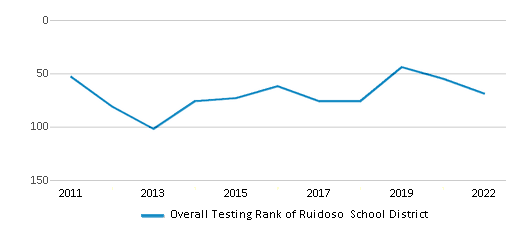
Math Test Scores (% Proficient)
22%
24%
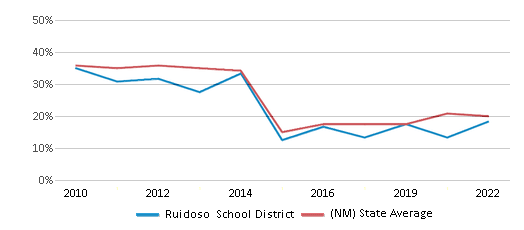
Reading/Language Arts Test Scores (% Proficient)
35%
34%

Science Test Scores (% Proficient)
37%
33%
Graduation Rate
(20-21)90-94%
66%
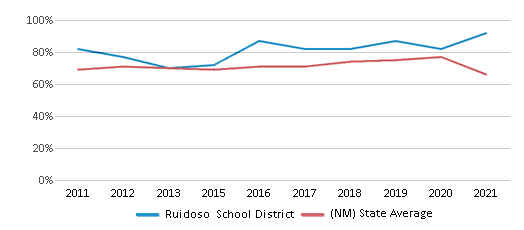
Students by Ethnicity:
Diversity Score
0.61
0.59
# American Indian Students
245 Students
12,899 Students
% American Indian Students
14%
13%
# Asian Students
24 Students
1,213 Students
% Asian Students
1%
1%
# Hispanic Students
973 Students
57,166 Students
% Hispanic Students
55%
59%
# Black Students
15 Students
1,819 Students
% Black Students
1%
2%
# White Students
502 Students
21,565 Students
% White Students
28%
22%
# Hawaiian Students
2 Students
134 Students
% Hawaiian Students
n/a
n/a
# Two or more races Students
19 Students
2,280 Students
% of Two or more races Students
1%
3%
Students by Grade:
# Students in PK Grade:
122
512
# Students in K Grade:
116
2,239
# Students in 1st Grade:
128
2,451
# Students in 2nd Grade:
119
2,615
# Students in 3rd Grade:
130
2,447
# Students in 4th Grade:
132
2,611
# Students in 5th Grade:
125
2,865
# Students in 6th Grade:
126
17,706
# Students in 7th Grade:
125
23,693
# Students in 8th Grade:
137
24,281
# Students in 9th Grade:
141
4,786
# Students in 10th Grade:
140
4,003
# Students in 11th Grade:
140
3,494
# Students in 12th Grade:
99
3,373
# Ungraded Students:
-
-
District Revenue and Spending
The revenue/student of $16,096 is higher than the state median of $14,756. The school district revenue/student has stayed relatively flat over four school years.
The school district's spending/student of $14,260 is higher than the state median of $14,121. The school district spending/student has stayed relatively flat over four school years.
Total Revenue
$29 MM
$4,694 MM
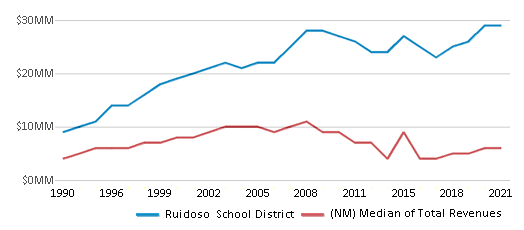
Spending
$25 MM
$4,492 MM

Revenue / Student
$16,096
$14,756
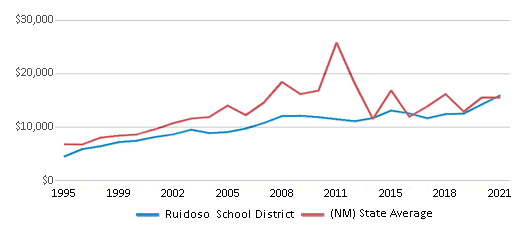
Spending / Student
$14,260
$14,121

Best Ruidoso School District Public Middle Schools (2025)
School
(Math and Reading Proficiency)
(Math and Reading Proficiency)
Location
Grades
Students
Rank: #11.
Ruidoso Middle School
(Math: 24% | Reading: 39%)
Rank:
Rank:
7/
Top 50%10
123 Warrior Dr
Ruidoso, NM 88345
(575) 257-4051
Ruidoso, NM 88345
(575) 257-4051
Grades: 6-8
| 388 students
Recent Articles

Year-Round Or Traditional Schedule?
Which is more appropriate for your child? A year-round attendance schedule or traditional schedule? We look at the pros and cons.

Why You Should Encourage Your Child to Join a Sports Team
Participating in team sports has a great many benefits for children, there is no doubt. In this article you will learn what those benefits are.

White Students are Now the Minority in U.S. Public Schools
Increasing birth rates among immigrant families from Asia and Central and South America, combined with lower birth rates among white families, means that for the first time in history, public school students in the United States are majority-minority. This shift in demographics poses difficulties for schools as they work to accommodate children of varying language abilities and socio-economic backgrounds.





